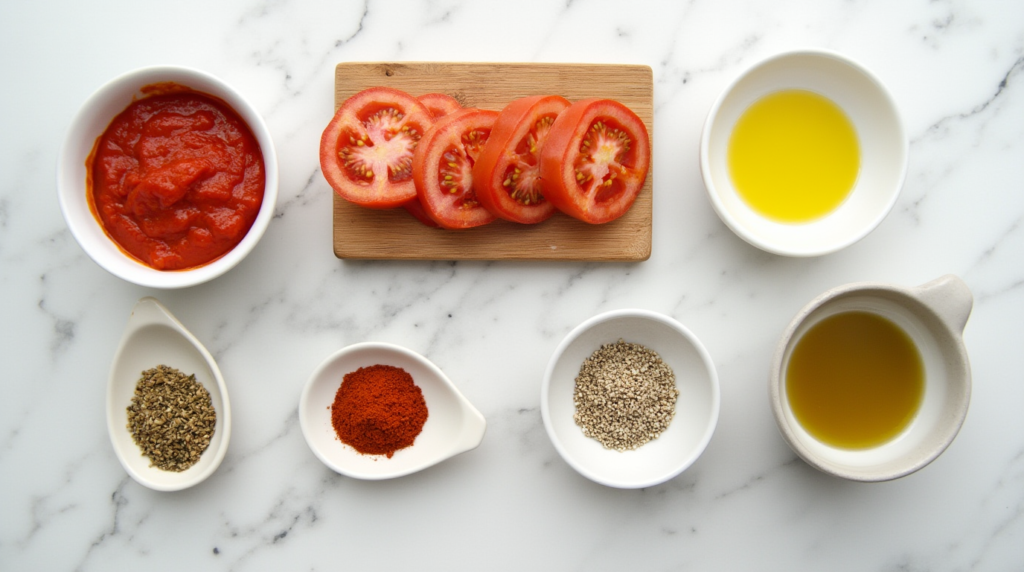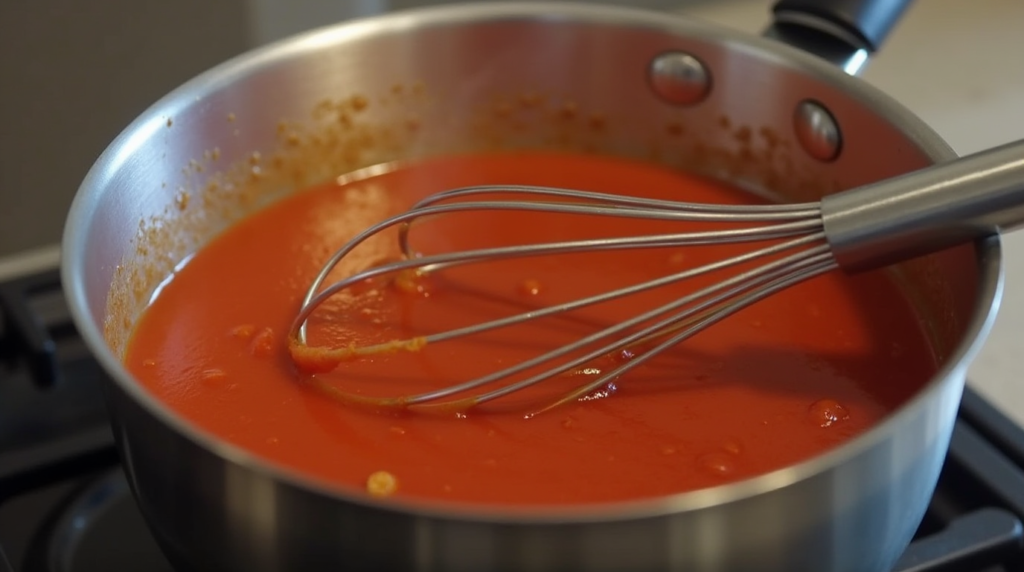Easy Pizza Sauce from Tomato Paste – 5-Minute Recipe
Are you looking for a quick and delicious solution for busy weeknights? You can make a rich and flavorful pizza sauce from tomato paste in just 5 minutes. This easy recipe is perfect for those who want to create a tasty meal without spending too much time in the kitchen.
Using tomato paste as the base, you can customize the sauce to your taste preferences. This quick pizza sauce recipe is ideal for anyone who wants to enjoy a homemade pizza without the hassle of cooking a sauce from scratch.
Key Takeaways
- Create a delicious pizza sauce in just 5 minutes
- Use tomato paste as a base for a rich and flavorful sauce
- Customize the sauce to your taste preferences
- Perfect for busy weeknights when you need a quick solution
- Easy to make and requires minimal ingredients
Why Make Pizza Sauce from Tomato Paste?
Creating your pizza sauce from tomato paste is a convenient and cost-effective solution. This method offers several advantages that make it an attractive option for home cooks.
Convenience and Pantry Staples
Tomato paste is a common pantry staple that can be easily stored and used whenever needed. Having it on hand allows you to whip up a batch of homemade pizza sauce in no time, making it ideal for spontaneous pizza nights.
Cost-Effectiveness
Using tomato paste is generally cheaper than buying pre-made pizza sauces or canned tomatoes. This method helps you save money while still enjoying high-quality, homemade pizza sauce.
Customizable Flavor Profile
With tomato paste, you can create a customizable flavor profile by adjusting the amount of herbs, spices, and other ingredients to suit your taste preferences. Whether you’re looking for a simple, classic sauce or something more complex, tomato paste provides a versatile base.
Some benefits of customizing your pizza sauce include:
- Adjusting the level of spiciness to your liking
- Adding fresh or dried herbs for unique flavor profiles
- Experimenting with different types of vinegar or citrus for a tangy twist
By making pizza sauce from tomato paste, you can enjoy a delicious and customizable sauce that’s perfect for your pizza nights.
Essential Ingredients for Tomato Paste Pizza Sauce
To make a mouth-watering tomato paste pizza sauce, you’ll need to gather a few essential ingredients. The quality and type of these ingredients can significantly impact the flavor and overall experience of your pizza.

Selecting the Right Tomato Paste
The foundation of your pizza sauce is the tomato paste. Opt for a high-quality, double-concentrated tomato paste for the best flavor. Brands like Mutti or Cento are well-regarded for their rich, intense tomato flavor. When selecting a tomato paste, consider the ingredient list and look for products with minimal added salt or preservatives.
Must-Have Herbs and Spices
To give your pizza sauce depth and authenticity, you’ll need a blend of herbs and spices. Essential ingredients include:
- Oregano: Adds a pungent, earthy flavor.
- Garlic powder: Provides a savory, slightly sweet taste.
- Salt: Enhances the overall flavor profile.
Optional Flavor Enhancers
To customize your pizza sauce, consider adding optional flavor enhancers such as:
- Olive oil: Adds richness and smoothness.
- Onion powder: Adds a savory, slightly sweet flavor.
- Red pepper flakes: Introduces a spicy kick.
Ingredient Substitutions
For those with dietary restrictions or preferences, ingredient substitutions can be made. For example, you can use gluten-free alternatives or vegan options. Here’s a simple table to guide you:
| Ingredient | Substitution |
|---|---|
| Garlic powder | Minced fresh garlic or garlic salt |
| Oregano | Dried or fresh basil, or Italian seasoning |
| Salt | Sea salt or Himalayan pink salt |
By understanding the essential ingredients and potential substitutions, you can create a tomato paste pizza sauce that suits your taste preferences and dietary needs.
Kitchen Tools You’ll Need
You’ll need a few simple tools to create your tomato paste pizza sauce. Having the right kitchen tools on hand makes the process efficient and enjoyable.
Basic Equipment
The basic equipment required includes a medium-sized saucepan for heating the sauce, a whisk or spoon for mixing, and a garlic press or grater for preparing additional flavor components. A measuring cup and spoons are also necessary for accurately measuring ingredients.
Time-Saving Alternatives
For those looking to save time, an immersion blender can be a valuable tool. It allows you to blend the sauce directly in the saucepan, eliminating the need to transfer it to a blender. This not only saves time but also reduces cleanup.
| Tool | Purpose |
|---|---|
| Saucepan | Heating the sauce |
| Whisk/Spoon | Mixing ingredients |
| Garlic Press/Grater | Preparing garlic and other flavor components |
| Immersion Blender | Blending sauce directly in the saucepan |
5-Minute Pizza Sauce from Tomato Paste Recipe
You can have a delicious homemade pizza sauce ready in just 5 minutes. This quick and easy recipe is perfect for pizza enthusiasts who want to elevate their homemade pizzas without spending too much time in the kitchen.
Measuring and Combining Ingredients
To start, measure out your ingredients, including 2-3 tablespoons of tomato paste, 1/2 cup of water, 1 tablespoon of olive oil, and your choice of herbs and spices, such as oregano, basil, garlic powder, salt, and pepper. Combine these ingredients in a saucepan, using a whisk or spoon to mix them thoroughly.

Mixing Techniques
The mixing technique is crucial to achieve a smooth sauce. Whisk the mixture continuously until the tomato paste is fully dissolved in the water and olive oil. If you prefer a slightly chunky sauce, you can stop whisking once the ingredients are well combined.
Adjusting Consistency
Depending on your desired sauce consistency, you may need to adjust it by adding more water or olive oil. For a thicker sauce, use less water; for a thinner sauce, add a bit more water. This simple adjustment allows you to customize the sauce to your pizza-making needs.
Taste Testing and Adjustments
Finally, taste the sauce and make any necessary adjustments to the seasoning. If it needs more salt, herbs, or spices, now is the time to add them. This step ensures that your pizza sauce is not only quick but also delicious and tailored to your taste preferences.
With this easy pizza sauce recipe, you can enjoy a simple tomato paste pizza sauce that’s ready in just a few minutes. It’s a quick pizza sauce solution that’s perfect for busy weeknights or spontaneous pizza nights.
The Secret to Perfect Pizza Sauce Texture
A great pizza starts with a great sauce, and getting the texture right is key. The perfect pizza sauce texture is a balance between being thick enough to stay on the dough and still being spreadable.
Balancing Thickness and Spreadability
To achieve the ideal balance, you can adjust the amount of liquid in your sauce. If it’s too thick, adding a bit more water or olive oil can help. Conversely, if it’s too thin, reducing the sauce through heating can thicken it to your liking.
How to Fix Common Texture Issues
Common issues with pizza sauce texture include being too thick or too thin. Here are some fixes:
- If your sauce is too thick, add a small amount of water or olive oil.
- If it’s too thin, simmer it for a few minutes to reduce the liquid.
- If your sauce has an uneven texture, try blending it for a smoother consistency.
Ideal Consistency for Different Pizza Styles
Different pizza styles require different sauce consistencies. For example:

- A Neapolitan-style pizza needs a very thin sauce.
- A Sicilian-style pizza can handle a thicker, chunkier sauce.
- For a New York-style pizza, the sauce should be somewhere in between.
Adjusting the consistency according to the pizza style you’re making will ensure the best results.
Flavor Variations to Customize Your Sauce
The beauty of homemade pizza sauce lies in its versatility, allowing you to experiment with a wide range of flavors. Once you’ve mastered the basic recipe, you can start tweaking it to suit your taste preferences or to complement different pizza toppings.
Spicy Pizza Sauce
If you like a bit of heat in your pizza, you can easily create a spicy pizza sauce by adding ingredients like red pepper flakes or diced jalapeños. Start with a small amount, such as 1/4 teaspoon of red pepper flakes, and adjust to taste. You can also use other spicy ingredients like diced serrano peppers or a splash of hot sauce to give your sauce an extra kick.
Herb-Forward Options
For those who prefer a more herbaceous flavor, you can emphasize the use of herbs like oregano, basil, or thyme. Try adding 1 tablespoon of chopped fresh oregano or 2 tablespoons of chopped fresh basil to your sauce for a distinct flavor profile. You can also combine different herbs to create a unique blend that complements your pizza toppings.
Sweet and Tangy Alternatives
If you prefer a sweeter or tangier sauce, you can incorporate ingredients like honey or balsamic vinegar. Adding 1 tablespoon of honey can balance out the acidity of the tomatoes, while 1-2 tablespoons of balsamic vinegar can add a rich, tangy flavor. Experiment with different amounts to find the perfect balance for your taste.
Regional Italian Inspirations
Exploring regional Italian flavors can also inspire interesting variations. For example, you can create a Tuscan-inspired sauce by adding ingredients like roasted garlic and fresh basil. Alternatively, a Sicilian-style sauce might include elements like olives, capers, or anchovies. The possibilities are endless, and experimenting with different regional flavors can add a new dimension to your homemade pizzas.
| Flavor Variation | Key Ingredients | Description |
|---|---|---|
| Spicy Pizza Sauce | Red pepper flakes, diced jalapeños | Adds a spicy kick to your pizza |
| Herb-Forward Options | Oregano, basil, thyme | Emphasizes the use of fresh or dried herbs |
| Sweet and Tangy Alternatives | Honey, balsamic vinegar | Balances out the acidity or adds a tangy flavor |
| Regional Italian Inspirations | Roasted garlic, olives, capers | Inspired by regional Italian flavors and ingredients |
Nutritional Benefits of Homemade Tomato Paste Pizza Sauce
Homemade tomato paste pizza sauce offers numerous nutritional benefits that can enhance your overall health. By making your sauce from scratch, you can control the ingredients and avoid unhealthy additives found in many commercial sauces.
Lycopene and Antioxidants
Tomato paste is rich in lycopene, a powerful antioxidant that has been linked to several health benefits, including reduced risk of certain cancers and heart disease. Lycopene’s antioxidant properties help protect cells from damage, promoting overall well-being.
Reduced Sodium and Preservatives
Store-bought pizza sauces often contain high amounts of sodium and preservatives to enhance flavor and extend shelf life. By making your sauce at home, you can significantly reduce these unhealthy components, making it a better choice for those with dietary restrictions.
Calorie Comparison with Store-Bought Options
Homemade tomato paste pizza sauce tends to be lower in calories compared to many commercial alternatives. This is especially true if you’re mindful of the ingredients you use, such as opting for herbs and spices for flavor instead of salt and sugar.
| Nutritional Aspect | Homemade Sauce | Store-Bought Sauce |
|---|---|---|
| Lycopene Content | High | Variable |
| Sodium Content | Low | High |
| Calorie Count | Lower | Higher |
| Preservatives | No | Yes |
By choosing to make your pizza sauce from tomato paste, you’re not only enhancing the flavor of your pizzas but also making a healthier choice for you and your family.
How to Store Your Homemade Pizza Sauce
Once you’ve prepared your homemade pizza sauce, you’ll want to store it in a way that preserves its quality. Proper storage ensures that your sauce remains fresh and ready for use in future meals.
Refrigeration Guidelines
For short-term storage, refrigeration is a suitable option. Transfer the sauce to an airtight container to prevent contamination and absorption of odors from other foods. Stored correctly, your pizza sauce can last up to a week in the refrigerator.
Freezing Methods
For longer storage, consider freezing your pizza sauce. Use airtight containers or freezer bags, making sure to label them with the date. Frozen pizza sauce can be stored for several months. When you’re ready to use it, simply thaw the desired amount.
Portion Control Tips
Dividing your pizza sauce into smaller portions before freezing can be very convenient. This way, you can thaw only what you need, reducing waste and saving time. Consider using ice cube trays for portioning out smaller amounts.
| Storage Method | Duration | Tips |
|---|---|---|
| Refrigeration | Up to 1 week | Use airtight containers |
| Freezing | Several months | Label containers with date, portion control |
Beyond Pizza: Other Uses for Your Tomato Paste Sauce
Tomato paste sauce is not just for pizza; it’s a multifaceted condiment that can enhance numerous recipes. Once you’ve prepared your homemade sauce, you can explore a variety of other dishes that benefit from its rich flavor.

Pasta Applications
One of the most straightforward uses for tomato paste sauce is as a pasta sauce. You can serve it with spaghetti, linguine, or any other pasta variety. Simply heat the sauce, toss it with your cooked pasta, and add some grated Parmesan cheese for a quick and delicious meal.
Dipping Sauce Ideas
Tomato paste sauce makes an excellent dipping sauce for various appetizers. Use it as a dip for breadsticks, garlic knots, or fried mozzarella cheese. You can also serve it alongside grilled or roasted vegetables for a tasty snack.
Creative Culinary Uses
Beyond traditional pasta and dipping sauces, tomato paste sauce can be used in numerous creative ways. Consider using it as a topping for baked potatoes, a sauce for meatballs or sausages, or as an ingredient in soups and stews. The possibilities are vast, and experimenting with different recipes can help you discover new favorite dishes.
| Use | Description |
|---|---|
| Pasta Sauce | Serve with spaghetti or linguine for a quick meal. |
| Dipping Sauce | Perfect for breadsticks, garlic knots, or fried mozzarella. |
| Topping for Baked Potatoes | Add flavor to your baked potatoes. |
| Sauce for Meatballs/Sausages | Enhance your meat dishes with this sauce. |
Conclusion
Creating an authentic pizza sauce recipe from tomato paste is a straightforward process that yields delicious results. By following the steps outlined in this article, you can enjoy a homemade pizza sauce that is not only tasty but also tailored to your dietary needs.
The benefits of homemade pizza sauce are numerous, including reduced sodium and preservatives, making it a healthier alternative to store-bought options. With this 5-minute recipe, you can have a delicious pizza sauce that’s perfect for pizza night or any other meal.
Experimenting with different flavors and applications will help you get the most out of your homemade tomato paste pizza sauce. Whether you’re looking to create a spicy pizza sauce or a more traditional Italian-inspired flavor, the versatility of this recipe is sure to impress. Enjoy the homemade pizza sauce benefits and start making your own delicious pizza sauce today!
FAQ
What is the best type of tomato paste to use for pizza sauce?
The best type of tomato paste to use is a high-quality, double-concentrated tomato paste, as it provides a rich and intense flavor.
Can I customize the flavor of my tomato paste pizza sauce?
Yes, you can customize the flavor by adding different herbs, spices, and other ingredients to suit your taste preferences.
How do I store homemade pizza sauce?
You can store homemade pizza sauce in the refrigerator for up to a week or freeze it for longer storage. Use airtight containers or freezer bags and label them with the date.
Can I use tomato paste pizza sauce for other dishes besides pizza?
Yes, tomato paste pizza sauce is versatile and can be used for pasta dishes, as a dipping sauce, or in various other culinary applications.
How do I achieve the perfect consistency for my pizza sauce?
To achieve the perfect consistency, adjust the amount of liquid in the sauce. If it’s too thick, add a little water or olive oil. If it’s too thin, reduce the sauce by heating it.
Is homemade pizza sauce healthier than store-bought options?
Yes, homemade pizza sauce is generally healthier because you can control the amount of sodium and preservatives that go into it, and it’s often lower in calories.
Can I make a quick and easy pizza sauce using tomato paste?
Yes, making pizza sauce from tomato paste is a quick and easy process that can be completed in just 5 minutes.
What are some flavor variations I can try with my tomato paste pizza sauce?
You can try making spicy pizza sauce by adding red pepper flakes, herb-forward options by emphasizing oregano or basil, or sweet and tangy alternatives by incorporating honey or balsamic vinegar.
Are you looking for a quick and delicious solution for busy weeknights? You can make a rich and flavorful pizza sauce using tomato paste in just 5 minutes. This easy recipe is perfect for those who want to create a tasty meal without spending too much time in the kitchen.
Using tomato paste as the base, you can customize the sauce to your taste preferences. This quick pizza sauce recipe is ideal for anyone who wants to enjoy a homemade pizza without the hassle of cooking a sauce from scratch.
Key Takeaways
- Create a delicious pizza sauce in just 5 minutes
- Use tomato paste as a base for a rich and flavorful sauce
- Customize the sauce to your taste preferences
- Perfect for busy weeknights when you need a quick solution
- Easy to make and requires minimal ingredients
Why Make Pizza Sauce from Tomato Paste?
Creating your pizza sauce from tomato paste is a convenient and cost-effective solution. This method offers several advantages that make it an attractive option for home cooks.
Convenience and Pantry Staples
Tomato paste is a common pantry staple that can be easily stored and used whenever needed. Having it on hand allows you to whip up a batch of homemade pizza sauce in no time, making it ideal for spontaneous pizza nights.
Cost-Effectiveness
Using tomato paste is generally cheaper than buying pre-made pizza sauces or canned tomatoes. This method helps you save money while still enjoying high-quality, homemade pizza sauce.
Customizable Flavor Profile
With tomato paste, you can create a customizable flavor profile by adjusting the amount of herbs, spices, and other ingredients to suit your taste preferences. Whether you’re looking for a simple, classic sauce or something more complex, tomato paste provides a versatile base.
Some benefits of customizing your pizza sauce include:
- Adjusting the level of spiciness to your liking
- Adding fresh or dried herbs for unique flavor profiles
- Experimenting with different types of vinegar or citrus for a tangy twist
By making pizza sauce from tomato paste, you can enjoy a delicious and customizable sauce that’s perfect for your pizza nights.
Essential Ingredients for Tomato Paste Pizza Sauce
To make a mouth-watering tomato paste pizza sauce, you’ll need to gather a few essential ingredients. The quality and type of these ingredients can significantly impact the flavor and overall experience of your pizza.
Selecting the Right Tomato Paste
The foundation of your pizza sauce is the tomato paste. Opt for a high-quality, double-concentrated tomato paste for the best flavor. Brands like Mutti or Cento are well-regarded for their rich, intense tomato flavor. When selecting a tomato paste, consider the ingredient list and look for products with minimal added salt or preservatives.
Must-Have Herbs and Spices
To give your pizza sauce depth and authenticity, you’ll need a blend of herbs and spices. Essential ingredients include:
- Oregano: Adds a pungent, earthy flavor.
- Garlic powder: Provides a savory, slightly sweet taste.
- Salt: Enhances the overall flavor profile.
Optional Flavor Enhancers
To customize your pizza sauce, consider adding optional flavor enhancers such as:
- Olive oil: Adds richness and smoothness.
- Onion powder: Adds a savory, slightly sweet flavor.
- Red pepper flakes: Introduces a spicy kick.
Ingredient Substitutions
For those with dietary restrictions or preferences, ingredient substitutions can be made. For example, you can use gluten-free alternatives or vegan options. Here’s a simple table to guide you:
| Ingredient | Substitution |
|---|---|
| Garlic powder | Minced fresh garlic or garlic salt |
| Oregano | Dried or fresh basil, or Italian seasoning |
| Salt | Sea salt or Himalayan pink salt |
By understanding the essential ingredients and potential substitutions, you can create a tomato paste pizza sauce that suits your taste preferences and dietary needs.
Kitchen Tools You’ll Need
You’ll need a few simple tools to create your tomato paste pizza sauce. Having the right kitchen tools on hand makes the process efficient and enjoyable.
Basic Equipment
The basic equipment required includes a medium-sized saucepan for heating the sauce, a whisk or spoon for mixing, and a garlic press or grater for preparing additional flavor components. A measuring cup and spoons are also necessary for accurately measuring ingredients.
Time-Saving Alternatives
For those looking to save time, an immersion blender can be a valuable tool. It allows you to blend the sauce directly in the saucepan, eliminating the need to transfer it to a blender. This not only saves time but also reduces cleanup.
| Tool | Purpose |
|---|---|
| Saucepan | Heating the sauce |
| Whisk/Spoon | Mixing ingredients |
| Garlic Press/Grater | Preparing garlic and other flavor components |
| Immersion Blender | Blending sauce directly in the saucepan |
5-Minute Pizza Sauce from Tomato Paste Recipe
You can have a delicious homemade pizza sauce ready in just 5 minutes. This quick and easy recipe is perfect for pizza enthusiasts who want to elevate their homemade pizzas without spending too much time in the kitchen.
Measuring and Combining Ingredients
To start, measure out your ingredients, including 2-3 tablespoons of tomato paste, 1/2 cup of water, 1 tablespoon of olive oil, and your choice of herbs and spices, such as oregano, basil, garlic powder, salt, and pepper. Combine these ingredients in a saucepan, using a whisk or spoon to mix them thoroughly.
Mixing Techniques
The mixing technique is crucial to achieve a smooth sauce. Whisk the mixture continuously until the tomato paste is fully dissolved in the water and olive oil. If you prefer a slightly chunky sauce, you can stop whisking once the ingredients are well combined.
Adjusting Consistency
Depending on your desired sauce consistency, you may need to adjust it by adding more water or olive oil. For a thicker sauce, use less water; for a thinner sauce, add a bit more water. This simple adjustment allows you to customize the sauce to your pizza-making needs.
Taste Testing and Adjustments
Finally, taste the sauce and make any necessary adjustments to the seasoning. If it needs more salt, herbs, or spices, now is the time to add them. This step ensures that your pizza sauce is not only quick but also delicious and tailored to your taste preferences.
With this easy pizza sauce recipe, you can enjoy a simple tomato paste pizza sauce that’s ready in just a few minutes. It’s a quick pizza sauce solution that’s perfect for busy weeknights or spontaneous pizza nights.
The Secret to Perfect Pizza Sauce Texture
A great pizza starts with a great sauce, and getting the texture right is key. The perfect pizza sauce texture is a balance between being thick enough to stay on the dough and still being spreadable.
Balancing Thickness and Spreadability
To achieve the ideal balance, you can adjust the amount of liquid in your sauce. If it’s too thick, adding a bit more water or olive oil can help. Conversely, if it’s too thin, reducing the sauce through heating can thicken it to your liking.
How to Fix Common Texture Issues
Common issues with pizza sauce texture include being too thick or too thin. Here are some fixes:
- If your sauce is too thick, add a small amount of water or olive oil.
- If it’s too thin, simmer it for a few minutes to reduce the liquid.
- If your sauce has an uneven texture, try blending it for a smoother consistency.
Ideal Consistency for Different Pizza Styles
Different pizza styles require different sauce consistencies. For example:
- A Neapolitan-style pizza needs a very thin sauce.
- A Sicilian-style pizza can handle a thicker, chunkier sauce.
- For a New York-style pizza, the sauce should be somewhere in between.
Adjusting the consistency according to the pizza style you’re making will ensure the best results.
Flavor Variations to Customize Your Sauce
The beauty of homemade pizza sauce lies in its versatility, allowing you to experiment with a wide range of flavors. Once you’ve mastered the basic recipe, you can start tweaking it to suit your taste preferences or to complement different pizza toppings.
Spicy Pizza Sauce
If you like a bit of heat in your pizza, you can easily create a spicy pizza sauce by adding ingredients like red pepper flakes or diced jalapeños. Start with a small amount, such as 1/4 teaspoon of red pepper flakes, and adjust to taste. You can also use other spicy ingredients like diced serrano peppers or a splash of hot sauce to give your sauce an extra kick.
Herb-Forward Options
For those who prefer a more herbaceous flavor, you can emphasize the use of herbs like oregano, basil, or thyme. Try adding 1 tablespoon of chopped fresh oregano or 2 tablespoons of chopped fresh basil to your sauce for a distinct flavor profile. You can also combine different herbs to create a unique blend that complements your pizza toppings.
Sweet and Tangy Alternatives
If you prefer a sweeter or tangier sauce, you can incorporate ingredients like honey or balsamic vinegar. Adding 1 tablespoon of honey can balance out the acidity of the tomatoes, while 1-2 tablespoons of balsamic vinegar can add a rich, tangy flavor. Experiment with different amounts to find the perfect balance for your taste.
Regional Italian Inspirations
Exploring regional Italian flavors can also inspire interesting variations. For example, you can create a Tuscan-inspired sauce by adding ingredients like roasted garlic and fresh basil. Alternatively, a Sicilian-style sauce might include elements like olives, capers, or anchovies. The possibilities are endless, and experimenting with different regional flavors can add a new dimension to your homemade pizzas.
| Flavor Variation | Key Ingredients | Description |
|---|---|---|
| Spicy Pizza Sauce | Red pepper flakes, diced jalapeños | Adds a spicy kick to your pizza |
| Herb-Forward Options | Oregano, basil, thyme | Emphasizes the use of fresh or dried herbs |
| Sweet and Tangy Alternatives | Honey, balsamic vinegar | Balances out the acidity or adds a tangy flavor |
| Regional Italian Inspirations | Roasted garlic, olives, capers | Inspired by regional Italian flavors and ingredients |
Nutritional Benefits of Homemade Tomato Paste Pizza Sauce
Homemade tomato paste pizza sauce offers numerous nutritional benefits that can enhance your overall health. By making your sauce from scratch, you can control the ingredients and avoid unhealthy additives found in many commercial sauces.
Lycopene and Antioxidants
Tomato paste is rich in lycopene, a powerful antioxidant that has been linked to several health benefits, including reduced risk of certain cancers and heart disease. Lycopene’s antioxidant properties help protect cells from damage, promoting overall well-being.
Reduced Sodium and Preservatives
Store-bought pizza sauces often contain high amounts of sodium and preservatives to enhance flavor and extend shelf life. By making your sauce at home, you can significantly reduce these unhealthy components, making it a better choice for those with dietary restrictions.
Calorie Comparison with Store-Bought Options
Homemade tomato paste pizza sauce tends to be lower in calories compared to many commercial alternatives. This is especially true if you’re mindful of the ingredients you use, such as opting for herbs and spices for flavor instead of salt and sugar.
| Nutritional Aspect | Homemade Sauce | Store-Bought Sauce |
|---|---|---|
| Lycopene Content | High | Variable |
| Sodium Content | Low | High |
| Calorie Count | Lower | Higher |
| Preservatives | No | Yes |
By choosing to make your pizza sauce from tomato paste, you’re not only enhancing the flavor of your pizzas but also making a healthier choice for you and your family.
How to Store Your Homemade Pizza Sauce
Once you’ve prepared your homemade pizza sauce, you’ll want to store it in a way that preserves its quality. Proper storage ensures that your sauce remains fresh and ready for use in future meals.
Refrigeration Guidelines
For short-term storage, refrigeration is a suitable option. Transfer the sauce to an airtight container to prevent contamination and absorption of odors from other foods. Stored correctly, your pizza sauce can last up to a week in the refrigerator.
Freezing Methods
For longer storage, consider freezing your pizza sauce. Use airtight containers or freezer bags, making sure to label them with the date. Frozen pizza sauce can be stored for several months. When you’re ready to use it, simply thaw the desired amount.
Portion Control Tips
Dividing your pizza sauce into smaller portions before freezing can be very convenient. This way, you can thaw only what you need, reducing waste and saving time. Consider using ice cube trays for portioning out smaller amounts.
| Storage Method | Duration | Tips |
|---|---|---|
| Refrigeration | Up to 1 week | Use airtight containers |
| Freezing | Several months | Label containers with date, portion control |
Beyond Pizza: Other Uses for Your Tomato Paste Sauce
Tomato paste sauce is not just for pizza; it’s a multifaceted condiment that can enhance numerous recipes. Once you’ve prepared your homemade sauce, you can explore a variety of other dishes that benefit from its rich flavor.
Pasta Applications
One of the most straightforward uses for tomato paste sauce is as a pasta sauce. You can serve it with spaghetti, linguine, or any other pasta variety. Simply heat the sauce, toss it with your cooked pasta, and add some grated Parmesan cheese for a quick and delicious meal.
Dipping Sauce Ideas
Tomato paste sauce makes an excellent dipping sauce for various appetizers. Use it as a dip for breadsticks, garlic knots, or fried mozzarella cheese. You can also serve it alongside grilled or roasted vegetables for a tasty snack.
Creative Culinary Uses
Beyond traditional pasta and dipping sauces, tomato paste sauce can be used in numerous creative ways. Consider using it as a topping for baked potatoes, a sauce for meatballs or sausages, or as an ingredient in soups and stews. The possibilities are vast, and experimenting with different recipes can help you discover new favorite dishes.
| Use | Description |
|---|---|
| Pasta Sauce | Serve with spaghetti or linguine for a quick meal. |
| Dipping Sauce | Perfect for breadsticks, garlic knots, or fried mozzarella. |
| Topping for Baked Potatoes | Add flavor to your baked potatoes. |
| Sauce for Meatballs/Sausages | Enhance your meat dishes with this sauce. |
Conclusion
Creating an authentic pizza sauce recipe from tomato paste is a straightforward process that yields delicious results. By following the steps outlined in this article, you can enjoy a homemade pizza sauce that is not only tasty but also tailored to your dietary needs.
The benefits of homemade pizza sauce are numerous, including reduced sodium and preservatives, making it a healthier alternative to store-bought options. With this 5-minute recipe, you can have a delicious pizza sauce that’s perfect for pizza night or any other meal.
Experimenting with different flavors and applications will help you get the most out of your homemade tomato paste pizza sauce. Whether you’re looking to create a spicy pizza sauce or a more traditional Italian-inspired flavor, the versatility of this recipe is sure to impress. Enjoy the homemade pizza sauce benefits and start making your own delicious pizza sauce today!
FAQ
What is the best type of tomato paste to use for pizza sauce?
The best type of tomato paste to use is a high-quality, double-concentrated tomato paste, as it provides a rich and intense flavor.
Can I customize the flavor of my tomato paste pizza sauce?
Yes, you can customize the flavor by adding different herbs, spices, and other ingredients to suit your taste preferences.
How do I store homemade pizza sauce?
You can store homemade pizza sauce in the refrigerator for up to a week or freeze it for longer storage. Use airtight containers or freezer bags and label them with the date.
Can I use tomato paste pizza sauce for other dishes besides pizza?
Yes, tomato paste pizza sauce is versatile and can be used for pasta dishes, as a dipping sauce, or in various other culinary applications.
How do I achieve the perfect consistency for my pizza sauce?
To achieve the perfect consistency, adjust the amount of liquid in the sauce. If it’s too thick, add a little water or olive oil. If it’s too thin, reduce the sauce by heating it.
Is homemade pizza sauce healthier than store-bought options?
Yes, homemade pizza sauce is generally healthier because you can control the amount of sodium and preservatives that go into it, and it’s often lower in calories.
Can I make a quick and easy pizza sauce using tomato paste?
Yes, making pizza sauce from tomato paste is a quick and easy process that can be completed in just 5 minutes.
What are some flavor variations I can try with my tomato paste pizza sauce?
You can try making spicy pizza sauce by adding red pepper flakes, herb-forward options by emphasizing oregano or basil, or sweet and tangy alternatives by incorporating honey or balsamic vinegar.
Leave a Review & Rate This Recipe!
There are no reviews yet. Be the first one to write one.

